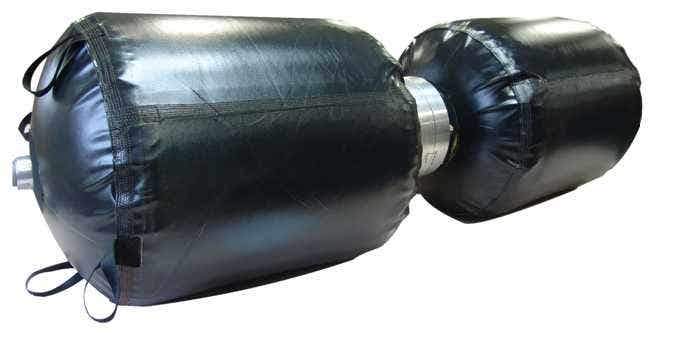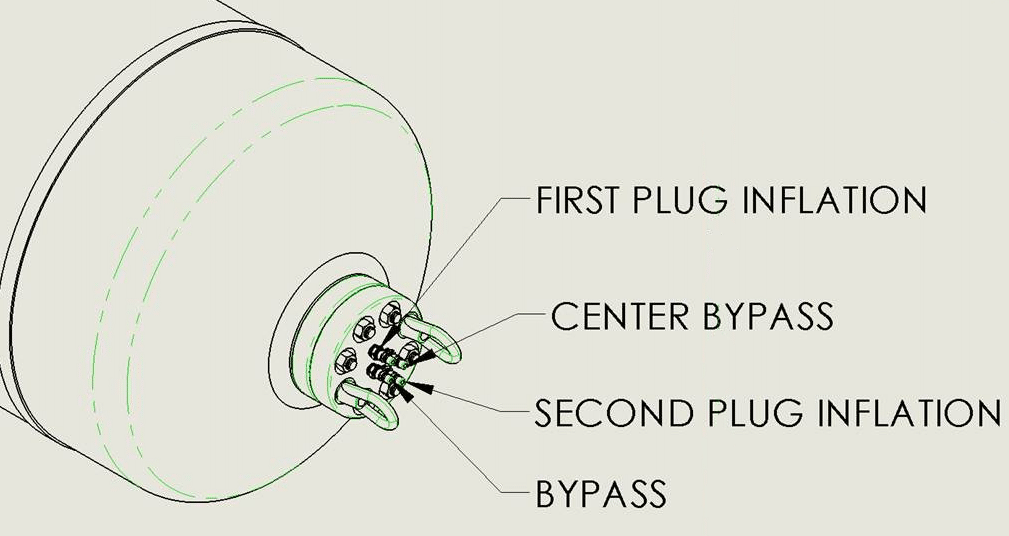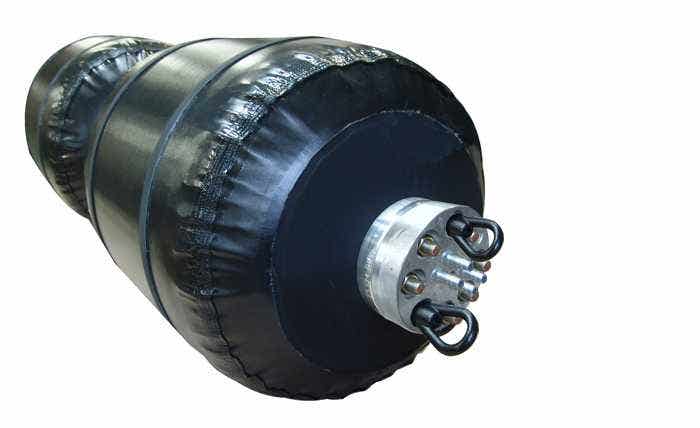Pipe Plug, MF, High Pressure, 127 Series Block & Bleed
Petersen Multi-Flex® Isolation Double Block & Bleed Inflatable Plug is a revolutionary Dual Seal plug to allow a positive isolation of toxic or flammable product. The vent between the two seals allows the operator to monitor the seal integrity, vent any product that seeps past the first seal, or introduce an inert gas or water between the seals for a positive isolation. These Isolation Block and Bleed plugs are available for most size, pressure, chemical, and temperature requirements.

| Image | Dia. Max | Dia. Deflated | Pipe Plug Inflation Max Press. | Pipeline Pressure Max Head | Port, Inflation | Length Deflated | Shipping Wt. | Item Number | Price | Qty | Action |
|---|---|---|---|---|---|---|---|---|---|---|---|

|
96" (2438mm) | 29" (737mm) | 15 psi (1.03 bar) | 7.5 psi (0.52 bar)/17.3' (5.27 m) | 6" X 300 lb | 400" (10160mm) | 360 Lb (163.29 Kg) | 127-096-BB |
$170,800.00
|
||

|
84" (2134mm) | 23" (584mm) | 15 psi (1.03 bar) | 7.5 psi (0.52 bar)/17.3' (5.27 m) | 6" X 300 lb | 352" (8941mm) | 330 Lb (149.69 Kg) | 127-084-BB |
$138,800.00
|
||

|
72" (1829mm) | 19" (483mm) | 20 psi (1.37 bar) | 10 psi (0.69 bar)/23.1' (7.03 m) | 6" X 300 lb | 304" (7722mm) | 300 Lb (136.058 Kg) | 127-072-BB |
$106,800.00
|
||

|
66" (1676mm) | 19" (483mm) | 20 psi (1.37 bar) | 10 psi (0.69 bar)/23.1' (7.03 m) | 4" X 300 lb | 280" (7112mm) | 285 Lb (129.28 Kg) | 127-066-BB |
$82,000.00
|
||

|
60" (1524mm) | 17" (431.8mm) | 20 psi (1.37 bar) | 10 psi (0.69 bar)/23.1' (7.03 m) | 4" X 300 lb | 256" (6502.4mm) | 268 Lb (121.56 Kg) | 127-060-BB |
$68,700.40
|
||

|
54" (1371.6mm) | 15" (381mm) | 30 psi (2.06 bar) | 15 psi (1.03 bar)/34.6' (10.55 m) | 4" X 300 lb | 232" (5892.8mm) | 264 Lb (119.75 Kg) | 127-054-BB |
$55,500.00
|
||

|
48" (1219.2mm) | 15" (381mm) | 30 psi (2.06 bar) | 15 psi (1.03 bar)/34.6' (10.55 m) | 4" X 300 lb | 208" (5283.20mm) | 229 Lb (103.87 Kg) | 127-048-BB |
$45,600.00
|
||

|
42" (1067mm) | 15" (381mm) | 40 psi (2.75 bar) | 20 psi (1.38 bar)/46' (14.06 m) | 4" X 300 lb | 184" (4674mm) | 203 Lb (92.08 Kg) | 127-042-BB |
$39,800.00
|
||

|
36" (914.4mm) | 11.75" (298.45mm) | 50 psi (3.44 bar) | 25 psi (1.72 bar)/57.7' (17.58 m) | 2" X 300 lb | 160" (4064mm) | 190 Lb (86.18 Kg) | 127-036-BB |
$27,200.00
|
||

|
30" (762mm) | 11.75" (298mm) | 60 psi (4.13 bar) | 30 psi (2.07 bar)/69.2' (21.1 m) | 2" X 300 lb | 136" (3454mm) | 173 Lb (78.47 Kg) | 127-030-BB |
$24,800.00
|
||

|
24" (610mm) | 11.75" (298mm) | 80 psi (5.51 bar) | 40 psi (2.76 bar)/92.3' (28.12 m) | 2" X 300 lb | 112" (2845mm) | 157 Lb (71.21 Kg) | 127-024-BB |
$15,000.00
|
||

|
20" (508mm) | 11.1" (282mm) | 80 psi (5.51 bar) | 40 psi (2.76 bar)/92.3' (28.12 m) | 2" X 300 lb | 96" (2438mm) | 155 Lb (70.31 Kg) | 127-020-BB |
$13,300.00
|
||

|
18" (457mm) | 11.1" (282mm) | 100 psi (6.89 bar) | 50 psi (3.45 bar)/115' (35.15 m) | 2" X 300 lb | 88" (2235mm) | 153 Lb (69.4 Kg) | 127-018-BB |
$10,200.00
|
||

|
16" (406mm) | 11.1" (282mm) | 100 psi (6.89 bar) | 50 psi (3.45 bar)/115' (35.15 m) | 2" X 300 lb | 80" (2032mm) | 148 Lb (67.13 Kg) | 127-016-BB |
$8,500.00
|
||

|
12" (305mm) | 9.5" (241mm) | 120 psi (8.27 bar) | 60 psi (4.14 bar)/138.4' (42.18 m) | 1/2" QDC Male | 80" (2032mm) | 140 Lb (63.5 Kg) | 127-012-BB |
$6,100.00
|
||

|
10" (254mm) | 9.5" (241mm) | 120 psi (8.27 bar) | 60 psi (4.14 bar)/138.4' (42.18 m) | 1/4" QDC Male | 80" (2032mm) | 122 Lb (55.33 Kg) | 127-010-BB |
$5,400.00
|
||

|
8" (203mm) | 7" (178mm) | 120 psi (8.27 bar) | 60 psi (4.14 bar)/138.4' (42.18 m) | 1/4" QDC Male | 68" (1727mm) | 42 Lb (19.05 Kg) | 127-008-BB |
$5,200.00
|
Benefits of Double Block and Bleed Inflatable Plugs
The Petersen Multi-Flex® Double Block and Bleed inflatable plug offers several key benefits:
- Enhanced Safety: Double Block & Bleed Inflatable Pipe Plug offer a high level of safety with a dual-seal mechanism and an intermediate bleed port. The design of our high-pressure block and bleed inflatable plugs ensures that if one seal fails, the second seal maintains isolation while the bleed port allows for any trapped pressure or fluids to be safely vented. This reduces the risk of hazardous leaks and pressure build-ups, protecting personnel and equipment during maintenance, repair, or testing operations. This is critical in high-risk environments, such as oil and gas or chemical processing facilities, where maintaining control over fluids and gases is paramount.
- Effective Isolation: The primary function of high-pressure block and bleed plugs is to effectively isolate sections of piping systems. Unlike traditional methods that may require depressurizing the entire pipeline, they allow targeted isolation, making it easier to conduct repairs, maintenance, or testing on specific sections. Our dual seal plug allows a positive isolation of toxic or flammable product. The vent between the two seals allows the operator to monitor the seal integrity, vent any product that seeps past the first seal, or introduce an inert gas or water between the seals for a positive isolation.
- Easy Deployment: The inflatable design of these high-pressure block and bleed plugs allow for quick and easy installation and removal. This simplifies the maintenance and testing processes. The plugs can be deployed by inflating them to the required pressure to create a workable seal. This reduces the time needed for setup, contributing to overall operational efficiency. The user-friendly nature also makes them accessible for use in planned maintenance and emergencies.
- Versatility: Our plugs are highly versatile, accommodating piping systems of various diameters, materials, and configurations. They are critical to oil and gas, petrochemicals, water utilities, and power generation. Their adaptability makes them suitable for different environments, whether it's offshore platforms, onshore facilities, or underground piping networks. Their versatility ensures they can be deployed in diverse applications, from high-pressure scenarios to low-pressure systems.
- Cost-Efficiency: By enabling targeted isolation and testing, these inflatable high-pressure block and bleed plugs help reduce operational downtime and the resources needed for maintenance activities. This leads to significant cost savings, providing a sense of security about the economic benefits of the product. There is no need to shut down the pipeline or depressurize entire systems fully, and by identifying leaks or pressure issues in isolated sections, these plugs help prevent potential damage or failures that could lead to costly repairs or environmental penalties.
How to Perform a Pressure Test Using Double Block and Bleed Isolation Plug?
Performing pressure testing using DBB plugs involves ensuring accuracy and safety. Here are some essential steps:
- BE SAFE: Ensure all personnel involved are trained and aware of potential hazards. NEVER use an inflatable plug when its failure could cause injury or catastrophic damage or as the only means of protection for personnel working downstream. Keep all personnel out of the plug end area – DANGER ZONE – when plug is in use.
- Preparation and Safety Checks: This phase involves specific procedures and safety protocols for pressure testing with DBB plugs. Inspect the plugs for any damage or wear, including the inflatable seals, bleed port, and associated valves and connections. Gather all required tools, such as inflation equipment, pressure gauges, and required fittings, and confirm that the plugs pressure rating matches the test specifications.
- DBB Isolation Plugs Installation: Next, clean the pipe section to remove debris, scale, or foreign materials. Insert the plug into the pipeline at the designated test location. Ensure it is positioned correctly with seals aligned at the intended isolation points. Use inflation equipment to pressurize the seals to the recommended pressure, confirming both seals are fully engaged and holding pressure without leaks.
- Establish Isolation and Bleed: Close the valves on the plug to isolate the test section. Also, open the bleed port between the two seals to vent any trapped air, pressure, or fluids from the isolated section. This ensures the integrity and effective isolation of the seals.
- Conduct the Pressure Test: Gradually introduce test pressure into the isolated pipe section using any pressure source. Slowly increase the pressure to the desired test level while monitoring the gauges. Hold the pressure for the required duration, typically specified by industry standards or project requirements, and check for any pressure drops that could indicate a leak or seal failure.
- Evaluation of Test Results: Measure, analyze, and document the pressure readings throughout the test. This includes initial pressure before the test starts, changing during the hold period, and the final pressure at the end of the test. Inspect the plug and the surrounding pipe section for any signs of leaks. Use the bleed port to confirm the seals maintained isolation throughout the test.
- De-Pressurize and Remove the Plug: Gradually open the pressure relief valves and release the pressure from the test section, ensuring controlled depressurization. Deflate the inflatable seals of the plug for safe removal, and carefully extract the plug from the pipeline.
- Post-Test Inspection and Reporting: It is important to inspect the equipment for signs of damage or wear from the test. Neatly clean and store the plug as per the manufacturer’s guidelines. Compile a report detailing pressure data, test procedures, or any issues encountered.
Applications of Double Block and Bleed Inflatable Plugs
Double block and bleed inflatable plugs are used across industries to ensure safe and efficient pipeline operations. These plugs provide secure isolation, facilitate maintenance, and enhance safety in high-pressure environments. Here are some typical applications of DBB plugs.
- Pipeline Maintenance and Repair: Our plugs, designed to isolate sections of pipelines, play a crucial role in pipeline maintenance and repair. They allow for maintenance, repair, or testing without draining the entire system, reducing downtime and minimizing exposure to hazardous materials. The bleed port between the seals enables pressure testing of the isolated section to verify pipeline integrity before resuming operation.
- Hydrostatic Testing: Hydrostatic testing isolates piping sections so water or another testing medium can be introduced to test for leaks without affecting the entire system.
- Pipeline Pigging Operations: They are used alongside pipeline pigging operations to isolate pipeline sections and control the flow of cleaning pigs or inspection tools.
- Nuclear and Petrochemical Industries: These plugs isolate sections of piping that carry highly toxic materials, ensuring safety during maintenance or testing operations.
- Emergency Shutoff: They act as an emergency shutoff measure in the pipeline rupture or significant leak, isolating the compromised section to prevent further damage or environmental contamination.
- Cross-Connection Control: These plugs prevent cross-contamination between different pipelines or sections. This is especially true in complex industrial systems where multiple substances are transported.
- Pipeline Abandonment: When a pipeline section is permanently abandoned, these plugs seal off the section to ensure it does not pose a hazard or leak into the environment.
Petersen Products offers high-pressure block and bleed, 127 BB series plug in various specifications. We have you covered for plug needs. For any doubts or queries, contact our experts or visit https://www.petersenproducts.com/ for detailed information.
FAQs
How can I choose the right DBB inflatable plug for a specific application?
Choosing the right inflatable plugs involves several considerations, such as the pipeline’s diameter, the material being transported, the overall pressure rating, and more. Following the manufacturer's specifications and guidelines can help in the proper selection.
Can I use DBB inflatable plugs in all pipeline sizes?
These inflatable plugs are available in various specifications to fit different pipeline diameters. However, selecting the appropriate size and type of plug for the specific pipeline and application is essential to ensure proper sealing and safety.
What safety considerations should I consider for inflatable plugs?
Very high forces are involved in many pipeline plugging situations that may cause injury or even death. Forces increase dramatically as pressure and pipe diameter increase. Take extreme care to assure the safe use of any inflatable pipe plug. Ensure the plug is correctly sized and rated for the pipeline's pressure and material type. Periodic inspection and maintenance of the plugs are also necessary to ensure their integrity and functionality.
Can I reuse DBB inflatable plugs?
Yes, you can use DBB inflatable plugs, which are inspected and maintained correctly after each use. Regular wear, damage, or deterioration checks are essential to ensure their reliability and effectiveness.
How do DBB inflatable plugs contribute to environmental safety?
These plugs prevent the release of hazardous materials during maintenance, testing, or in the event of a pipeline failure. By ensuring a secure isolation of pipeline sections, they reduce the risk of environmental contamination and enhance overall safety.







